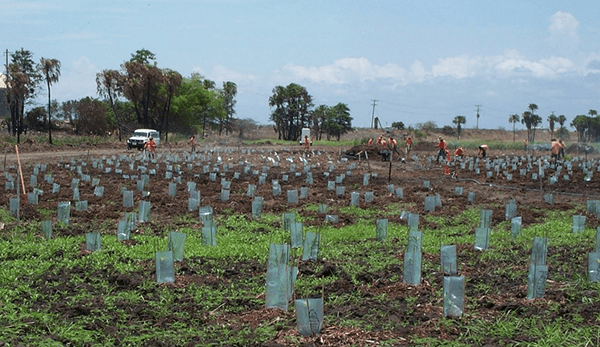|
|
Active revegetationActive revegetation involves the introduction and re-establishment of vegetation at a site using one or more methods. These can include planting of advanced tubestock germinated in nurseries, transplants obtained from within or external to the rehabilitation site, direct seeding or hydromulching. Active revegetation is most appropriate for sites where native vegetation has been removed and is not naturally recruiting, for sites where there is a need to establish vegetation cover as quickly as possible to avoid soil erosion risks, or sites where implementation of engineered solutions have disturbed vegetation. Active revegetation can be used to support assisted natural regeneration by establishing pioneer species or founder populations for the natural regeneration processes. It is also used to revegetate the more disturbed areas of a site where assisted regeneration is not viable. Active revegetation is most commonly conducted for terrestrial plant species or emergent aquatic macrophytes in the riparian zone adjoining stream channels or on exposed areas of the riverbed within the channel. Potential benefits from this intervention:
Potential negative implication from this intervention:
Intervention considerations:
Additional informationPublications: Chenoweth EPLA and Bushland Restoration Services. 2012. South East Queensland Ecological Restoration Framework: Guideline. Prepared on behalf of SEQ Catchments and South East Queensland Local Governments, Brisbane. Chenoweth EPLA and Bushland Restoration Services. 2012. South East Queensland Ecological Restoration Framework: Manual. Prepared on behalf of SEQ Catchments and South East Queensland Local Governments. Brisbane. DEEDI. 2011. Grazing for Healthy Coastal wetlands: Guidelines for managing coastal wetlands in grazing systems. State of Queensland, Department of Employment, Economic Development and Innovation, Brisbane. Price, P. and Lovett, S. 1999. Riparian Land Management Technical Guidelines. LWRRDC. Canberra. Rutherfurd, I.D., Jerie, K. and Marsh, N. 2000. A Rehabilitation Manual for Australian Streams, Volumes 1 and 2. CRC for Catchment Hydrology and LWRRDC. Canberra. Links: Resources - Queensland Fire and Biodiversity Consortium Last updated: 22 June 2022 This page should be cited as: Department of Environment, Science and Innovation, Queensland (2022) Active revegetation, WetlandInfo website, accessed 8 May 2025. Available at: https://wetlandinfo.des.qld.gov.au/wetlands/management/rehabilitation/rehab-process/step-4/intervention-options/active-revegetation-mod.html |

 — Department of the Environment, Tourism, Science and Innovation
— Department of the Environment, Tourism, Science and Innovation


